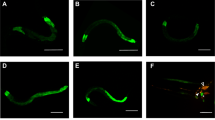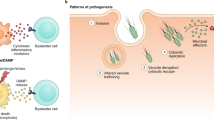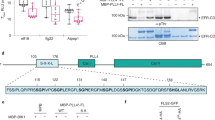Abstract
Immune defenses are triggered by microbe-associated molecular patterns or as a result of damage to host cells. The elicitors of immune responses in the nematode Caenorhabditis elegans are unclear. Using a genome-wide RNA-mediated interference (RNAi) screen, we identified the G protein–coupled receptor (GPCR) DCAR-1 as being required for the response to fungal infection and wounding. DCAR-1 acted in the epidermis to regulate the expression of antimicrobial peptides via a conserved p38 mitogen-activated protein kinase pathway. Through targeted metabolomics analysis we identified the tyrosine derivative 4-hydroxyphenyllactic acid (HPLA) as an endogenous ligand. Our findings reveal DCAR-1 and its cognate ligand HPLA to be triggers of the epidermal innate immune response in C. elegans and highlight the ancient role of GPCRs in host defense.
This is a preview of subscription content, access via your institution
Access options
Subscribe to this journal
Receive 12 print issues and online access
$209.00 per year
only $17.42 per issue
Buy this article
- Purchase on Springer Link
- Instant access to full article PDF
Prices may be subject to local taxes which are calculated during checkout







Similar content being viewed by others
References
Ausubel, F.M. Are innate immune signaling pathways in plants and animals conserved? Nat. Immunol. 6, 973–979 (2005).
Mallo, G.V. et al. Inducible antibacterial defense system in C. elegans. Curr. Biol. 12, 1209–1214 (2002).
Kim, D.H. et al. A conserved p38 MAP kinase pathway in Caenorhabditis elegans innate immunity. Science 297, 623–626 (2002).
Visvikis, O. et al. Innate host defense requires TFEB-mediated transcription of cytoprotective and antimicrobial genes. Immunity 40, 896–909 (2014).
Shapira, M. et al. A conserved role for a GATA transcription factor in regulating epithelial innate immune responses. Proc. Natl. Acad. Sci. USA 103, 14086–14091 (2006).
Lee, K.A. et al. Bacterial-derived uracil as a modulator of mucosal immunity and gut-microbe homeostasis in Drosophila. Cell 153, 797–811 (2013).
Saunders, C.J., Christensen, M., Finger, T.E. & Tizzano, M. Cholinergic neurotransmission links solitary chemosensory cells to nasal inflammation. Proc. Natl. Acad. Sci. USA 111, 6075–6080 (2014).
Tizzano, M. et al. Nasal chemosensory cells use bitter taste signaling to detect irritants and bacterial signals. Proc. Natl. Acad. Sci. USA 107, 3210–3215 (2010).
Lee, R.J. et al. Bitter and sweet taste receptors regulate human upper respiratory innate immunity. J. Clin. Invest. 124, 1393–1405 (2014).
Reddy, K.C., Andersen, E.C., Kruglyak, L. & Kim, D.H. A polymorphism in npr-1 is a behavioral determinant of pathogen susceptibility in C. elegans. Science 323, 382–384 (2009).
Powell, J.R., Kim, D.H. & Ausubel, F.M. The G protein-coupled receptor FSHR-1 is required for the Caenorhabditis elegans innate immune response. Proc. Natl. Acad. Sci. USA 106, 2782–2787 (2009).
McEwan, D.L., Kirienko, N.V. & Ausubel, F.M. Host translational inhibition by Pseudomonas aeruginosa exotoxin A triggers an immune response in Caenorhabditis elegans. Cell Host Microbe 11, 364–374 (2012).
Melo, J.A. & Ruvkun, G. Inactivation of conserved C. elegans genes engages pathogen- and xenobiotic-associated defenses. Cell 149, 452–466 (2012).
Dunbar, T.L., Yan, Z., Balla, K.M., Smelkinson, M.G. & Troemel, E.R. C. elegans detects pathogen-induced translational inhibition to activate immune signaling. Cell Host Microbe 11, 375–386 (2012).
Partridge, F.A., Gravato-Nobre, M.J. & Hodgkin, J. Signal transduction pathways that function in both development and innate immunity. Dev. Dyn. 239, 1330–1336 (2010).
Pukkila-Worley, R. & Ausubel, F.M. Immune defense mechanisms in the Caenorhabditis elegans intestinal epithelium. Curr. Opin. Immunol. 24, 3–9 (2012).
Dijksterhuis, J., Veenhuis, M. & Harder, W. Ultrastructural study of adhesion and initial stages of infection of the nematode by conidia of Drechmeria coniospora. Mycol. Res. 94, 1–8 (1990).
Couillault, C. et al. TLR-independent control of innate immunity in Caenorhabditis elegans by the TIR domain adaptor protein TIR-1, an ortholog of human SARM. Nat. Immunol. 5, 488–494 (2004).
Pujol, N. et al. Anti-fungal innate immunity in C. elegans is enhanced by evolutionary diversification of antimicrobial peptides. PLoS Pathog. 4, e1000105 (2008).
Pujol, N. et al. Distinct innate immune responses to infection and wounding in the C. elegans epidermis. Curr. Biol. 18, 481–489 (2008).
Dierking, K. et al. Unusual regulation of a STAT protein by an SLC6 family transporter in C. elegans epidermal innate immunity. Cell Host Microbe 9, 425–435 (2011).
Ziegler, K. et al. Antifungal innate immunity in C. elegans: PKCdelta links G protein signaling and a conserved p38 MAPK cascade. Cell Host Microbe 5, 341–352 (2009).
Squiban, B., Belougne, J., Ewbank, J. & Zugasti, O. Quantitative and automated high-throughput genome-wide RNAi screens in C. elegans. J. Vis. Exp. 60, e3448 (2012).
Labed, S.A., Omi, S., Gut, M., Ewbank, J.J. & Pujol, N. The pseudokinase NIPI-4 is a novel regulator of antimicrobial peptide gene expression. PLoS ONE 7, e33887 (2012).
Aoki, R. et al. A seven-transmembrane receptor that mediates avoidance response to dihydrocaffeic acid, a water-soluble repellent in Caenorhabditis elegans. J. Neurosci. 31, 16603–16610 (2011).
Rohlfing, A.K., Miteva, Y., Hannenhalli, S. & Lamitina, T. Genetic and physiological activation of osmosensitive gene expression mimics transcriptional signatures of pathogen infection in C. elegans. PLoS ONE 5, e9010 (2010).
Wheeler, J.M. & Thomas, J.H. Identification of a novel gene family involved in osmotic stress response in Caenorhabditis elegans. Genetics 174, 1327–1336 (2006).
Cox, G.N., Laufer, J.S., Kusch, M. & Edgar, R.S. Genetic and Phenotypic Characterization of Roller Mutants of Caenorhabditis elegans. Genetics 95, 317–339 (1980).
Ferguson, A.A. et al. TATN-1 mutations reveal a novel role for tyrosine as a metabolic signal that influences developmental decisions and longevity in Caenorhabditis elegans. PLoS Genet. 9, e1004020 (2013).
Muir, R.E. & Tan, M.W. Virulence of Leucobacter chromiireducens subsp. solipictus to Caenorhabditis elegans: characterization of a novel host-pathogen interaction. Appl. Environ. Microbiol. 74, 4185–4198 (2008).
Hodgkin, J., Felix, M.A., Clark, L.C., Stroud, D. & Gravato-Nobre, M.J. Two Leucobacter strains exert complementary virulence on Caenorhabditis including death by worm-star formation. Curr. Biol. 23, 2157–2161 (2013).
Mrochek, J.E., Dinsmore, S.R. & Ohrt, D.W. Monitoring phenylalanine-tyrosine metabolism by high-resolution liquid chromatography of urine. Clin. Chem. 19, 927–936 (1973).
Mayatepek, E., Seppel, C.K. & Hoffmann, G.F. Increased urinary excretion of dicarboxylic acids and 4-hydroxyphenyllactic acid in patients with Zellweger syndrome. Eur. J. Pediatr. 154, 755–756 (1995).
Bargmann, C.I. in WormBook 1–29 〈http://www.wormbook.org〉 (2006).
Stewart, M.K., Clark, N.L., Merrihew, G., Galloway, E.M. & Thomas, J.H. High genetic diversity in the chemoreceptor superfamily of Caenorhabditis elegans. Genetics 169, 1985–1996 (2005).
Thomas, J.H., Kelley, J.L., Robertson, H.M., Ly, K. & Swanson, W.J. Adaptive evolution in the SRZ chemoreceptor families of Caenorhabditis elegans and Caenorhabditis briggsae. Proc. Natl. Acad. Sci. USA 102, 4476–4481 (2005).
Pradel, E. et al. Detection and avoidance of a natural product from the pathogenic bacterium Serratia marcescens by Caenorhabditis elegans. Proc. Natl. Acad. Sci. USA 104, 2295–2300 (2007).
Pujol, N. & Ewbank, J.J. in Toll Receptors (ed. Rich, T.) Ch. 7, (Landes Bioscience Press, 2003).
Kim, T.H., Hwang, S.B., Jeong, P.Y., Lee, J. & Cho, J.W. Requirement of tyrosylprotein sulfotransferase-A for proper cuticle formation in the nematode C. elegans. FEBS Lett. 579, 53–58 (2005).
Kamath, R.S. et al. Systematic functional analysis of the Caenorhabditis elegans genome using RNAi. Nature 421, 231–237 (2003).
Rual, J.F. et al. Toward improving Caenorhabditis elegans phenome mapping with an ORFeome-based RNAi library. Genome Res. 14, 2162–2168 (2004).
Xu, S. & Chisholm, A.D.A. Gα(q)-Ca2+ signaling pathway promotes actin-mediated epidermal wound closure in C. elegans. Curr. Biol. 21, 1960–1967 (2011).
Hobert, O. PCR fusion-based approach to create reporter gene constructs for expression analysis in transgenic C. elegans. Biotechniques 32, 728–730 (2002).
Stringham, E., Pujol, N., Vandekerckhove, J. & Bogaert, T. unc-53 controls longitudinal migration in C. elegans. Development 129, 3367–3379 (2002).
Pujol, N. et al. A reverse genetic analysis of components of the Toll signalling pathway in Caenorhabditis elegans. Curr. Biol. 11, 809–821 (2001).
Jansson, H.B. Attraction of nematodes to endo-parasitic nematophagous fungi. Trans. Br. Mycol. Soc. 79, 25–29 (1982).
Pulak, R. Techniques for analysis, sorting, and dispensing of C. elegans on the COPAS flow-sorting system. Methods Mol. Biol. 351, 275–286 (2006).
von Reuss, S.H. et al. Comparative metabolomics reveals biogenesis of ascarosides, a modular library of small-molecule signals in C. elegans. J. Am. Chem. Soc. 134, 1817–1824 (2012).
Acknowledgements
We thank A. Chisholm (University of California, San Diego) for vector pCZGY1434; S. Mitani (Tokyo Women's Medical University School of Medicine) for strain tir-1(tm3036); Y. Goshima (Yokohama City University) for strains dcar-1(nj66) and dcar-1(tm2484), dcar-1 cDNA, and plasmids sra-6p∷dcar-1∷Venus and sra-6p∷dcar-1; C. Bargmann, A. Chisholm, C. Couillault, P. Golstein and E. Vivier for critical reading of the manuscript; M. Metwaly, F. Montañana-Sanchis, S. Omi, J. Soulé and the staff at WormBase and ModulBio for technical support; and C. Melon for advice. Nematode strains pmk-1(km25) and gpa-12(pk322) were provided by the Caenorhabditis Genetics Center, which is funded by the Office of Research Infrastructure Programs of the US National Institutes of Health (P40 OD010440); dcar1(tm2484) was provided by the National Bioresource Project coordinated by S. Mitani. Supported by INSERM, CNRS, the PACA Regional Council, the Agence Nationale de Recherche (MIME-2007, ANR-12-BSV3-0001-01, ANR-11-LABX-0054 (Investissements d'Avenir–Labex INFORM) and ANR-11-IDEX-0001-02 (Investissements d'Avenir–A*MIDEX)), the US National Institutes of Health (GM088290 to F.C.S.) and the Fondation Association pour la Recherche sur le Cancer (B.S.).
Author information
Authors and Affiliations
Contributions
O.Z. designed and did the RNAi screen and most other experiments, analyzed and interpreted the data and helped write the manuscript; B.S., J.B. and C.L.K. did the RNAi screen, analyzed and interpreted the data and reviewed the manuscript; N.B and F.C.S. designed and did the mass spectrometry analyses, analyzed and interpreted data and helped write the manuscript; N.P. designed experiments, analyzed and interpreted data and helped write the manuscript; and J.J.E. conceived of and supervised the project, designed experiments, analyzed and interpreted the data and wrote the manuscript.
Corresponding authors
Ethics declarations
Competing interests
The authors declare no competing financial interests.
Integrated supplementary information
Supplementary Figure 1 The GPCR DCAR-1 controls AMP gene expression following fungal infection and wounding.
Normalized fluorescence ratio in wild type and dcar-1(tm2484) worms carrying the integrated array frIs7 (which contains the reporter transgenes nlp-29p::gfp and col-12p::DsRed) after infection by D. coniospora (left panel), wounding (middle left panel) and osmotic stress (middle right panel), and in wild type and dcar-1(tm2484) worms that in addition to frIs7 carry frIs30, an integrated transgene that encodes a constitutively active form of GPA-12 (GPA-12*; right panel). In all cases, the results are representative of at least three independent experiments with a minimum of 50 worms for each condition.
Supplementary Figure 2 DCAR-1 acts in an epidermis-specific and cell-autonomous manner to regulate the induction of nlp-29 AMP gene.
a, Normalized fluorescence ratio of wild type worms carrying frIs7 treated with RNAi against control (sta-1, gfp, sta-2) or candidate genes (osm-9 and ocr-2) and infected or not. b, Normalized fluorescence ratio of worms carrying frIs7 in rde-1(ne219);col-19p::rde-1 worms that are resistant to RNAi except in the adult epidermis treated with RNAi against control genes (sta-1, gfp, sta-2) or dcar-1 and infected or not. The results are representative of at least three independent experiments with a minimum of 50 worms for each condition.
Supplementary Figure 3 DCAR-1 acts in the epidermis to regulate nlp gene expression and resistance to infection with D. coniospora.
a, Survival of wild-type, dcar-1(tm2484), dcar-1;dcar-1p::dcar-1::gfp, dcar-1;col-12p::dcar-1::gfp and sra-6p::dcar-1::Venus worms after infection with D. coniospora. For the experiment shown here, n= 70, 65, 67, 67 and 70 respectively). The statistical significance of the differences between strains is shown below the graph (one-sided log rank test). b, c Quantitative RT-PCR analysis of the expression of genes in the nlp-29 cluster in wild-type, dcar-1(tm2484) and dcar-1;dcar-1p::dcar-1::gfp (b) or wild-type, dcar-1(tm2484), dcar-1;col-12p::dcar-1 and dcar-1;sra-6p::dcar-1 worms (c) after infection with D. coniospora. Data are from three independent experiments (average and SD). d, Survival of wild-type, dcar-1(tm2484), dcar-1;col-12p::dcar-1 and with sra-6p::dcar-1 worms after infection with D. coniospora. For the experiment shown here, n= 62, 71, 55 and 65 respectively). The statistical significance of the difference between strains is shown below the graph (one-sided log rank test). The difference in survival between the strains common to the experiments shown in a and d is linked to a variation in pathogenicity between different preparations of fungal spores used in experiments performed on different days.
Supplementary Figure 4 DHCA triggers PMK-1-dependent gene expression in the epidermis.
Quantitative RT-PCR analysis of the expression of genes in the nlp-29 cluster in wild-type and pmk-1 worms treated with 5 mM DHCA for 2 h (a) or of the intestinal defence genes F49F1.6 and F57F4.4 (that require PMK-1 for their expression) and pgp-5, irg-1, irg-3 (that do not require PMK-1 for their expression)1,2 in wild-type and dcar-1(tm2484) worms after exposure to 5 mM DHCA for 2 h (b) or 5 h (c). Data are from three independent experiments (average and SD). The qualitative effect on nlp gene expression in the pmk-1 mutant mirrors that seen upon infection3, also with an apparent partial pmk-1-independent component for the induction of nlp-31 and nlp-34. Although exposure of worms to DHCA was sufficient to increase epidermal AMP gene expression, pre-treatment of worms with it did not provide any measurable protection against infection (results not shown).
1 - Estes, K. A., Dunbar, T. L., Powell, J. R., Ausubel, F. M. & Troemel, E. R. bZIP transcription factor zip-2 mediates an early response to Pseudomonas aeruginosa infection in Caenorhabditis elegans. Proc Natl Acad Sci U S A 107, 2153-2158 (2010).
2 - Dierking, K. et al. Unusual regulation of a STAT protein by an SLC6 family transporter in C. elegans epidermal innate immunity. Cell Host Microbe 9, 425-435 (2011).
3 - Pujol, N. et al. Distinct innate immune responses to infection and wounding in the C. elegans epidermis. Curr Biol 18, 481-489 (2008).
Supplementary Figure 5 Molecules that are structurally related to DHCA but do not trigger expression of the nlp-29p::gfp reporter gene.
Chemical structures of 3,4-hydroxy phenyl propionic acid (HPA), 4-hydroxyphenylpyruvic acid (HPPA), 3-4-dihydroxyphenyl lactic acid (DPLA), tyrosine, L-3,4-dihydroxyphenylalanine (DOPA), 3,4-dihydrobenzaldehyde (DHB), 3,4-dihydroxyphenylacetic acid (DOPAC), 3,4-dihyroxybenzoic acid (DHBA), and 3,4 dihydroxymandelic acid (DHMA), together with normalized fluorescence ratio of young adult wild type worms carrying frIs7 treated for 2 h at 25°C with increasing concentrations of the indicated chemical. Data are representative of at least three independent experiments with a minimum of 50 worms for each condition. Compounds previously found to act as DCAR-1 ligands in a Xenopus oocyte system, and their relative potency are indicated (*** medium; ** low; * weak). Tyrosine and DOPA were also tested and had no effect4. As the epidermis of C. elegans is surrounded by a cuticle that is relatively impermeable to many compounds5–6, we cannot formally exclude the possibility that lack of reporter gene expression in our assay results from a failure of a given compound to reach DCAR-1 in vivo. Nor can we exclude the possibility that different compounds have different pharmacokinetic properties.
4 - Aoki, R. et al. A seven-transmembrane receptor that mediates avoidance response to dihydrocaffeic acid, a water-soluble repellent in Caenorhabditis elegans. J Neurosci 31, 16603-16610 (2011).
5 - Partridge, F. A., Tearle, A. W., Gravato-Nobre, M. J., Schafer, W. R. & Hodgkin, J. The C. elegans glycosyltransferase BUS-8 has two distinct and essential roles in epidermal morphogenesis. Dev Biol 317, 549-559 (2008).
6 - Zheng, S. Q., Ding, A. J., Li, G. P., Wu, G. S. & Luo, H. R. Drug absorption efficiency in Caenorhbditis elegans delivered by different methods. PLoS One 8, e56877 (2013).
Supplementary Figure 6 Knocking down individual enzymes potentially involved in HPLA metabolism has no effect on nlp-29p::gfp expression.
a, Part of the tyrosine metabolic pathway, showing the names and structures of intermediates and the names of selected candidate enzymes which potentially catalyze each step. To the best of our knowledge, how the keto of HPPA is converted into the hydroxy function of HPLA has not been elucidated in any eukaryotic species. b, Normalized fluorescence ratio of young adult IG1502 rde-1(ne219) V; Is[wrt-2p::rde-1; myo-2p::rfp]; frIs7 IV worms that are resistant to RNAi except in the epidermis (infected or not, left panel) or dpy-10 worms (right panel) carrying frIs7 treated with RNAi against control (sta-1, gfp and dcar-1) or candidate genes. Data are representative of at least two independent experiments with a minimum of 50 worms for each condition.
Supplementary Figure 7 Pathways leading to expression of nlp-29, highlighting the newly discovered roles of HPLA and DCAR-1.
Infection with D. coniospora and physical injury trigger up-regulation of the AMP nlp genes in the epidermis via the Gα protein GPA-12 that acts upstream of the PKCδ TPA-1, the TIR-domain adapter protein TIR-1 and a p38 MAPK cascade involving NSY-1, SEK-1 and PMK-1, as well as the STAT transcription factor-like protein STA-2. We found that the level of HPLA, which is potentially derived from tyrosine, increases upon infection. The precise site and mode of production of HPLA awaits elucidation; tyrosine is placed here at the level of the cuticle for the purpose of illustration. HPLA triggers nlp-29 gene expression via its cognate receptor DCAR-1, which is expressed at the apical surface of the epidermal syncytium hyp7. dcar-1 acts upstream of GPA-12, the p38 MAPK cassette and STA-2.
Supplementary information
Supplementary Text and Figures
Supplementary Figures 1–7 and Supplementary Table 1 (PDF 4263 kb)
Rights and permissions
About this article
Cite this article
Zugasti, O., Bose, N., Squiban, B. et al. Activation of a G protein–coupled receptor by its endogenous ligand triggers the innate immune response of Caenorhabditis elegans. Nat Immunol 15, 833–838 (2014). https://doi.org/10.1038/ni.2957
Received:
Accepted:
Published:
Issue Date:
DOI: https://doi.org/10.1038/ni.2957
This article is cited by
-
Nanoscale patterning of collagens in C. elegans apical extracellular matrix
Nature Communications (2023)
-
GPR97 deficiency ameliorates renal interstitial fibrosis in mouse hypertensive nephropathy
Acta Pharmacologica Sinica (2023)
-
Cisplatin toxicity is counteracted by the activation of the p38/ATF-7 signaling pathway in post-mitotic C. elegans
Nature Communications (2023)
-
Dissecting the genetic landscape of GPCR signaling through phenotypic profiling in C. elegans
Nature Communications (2023)
-
C. elegans: out on an evolutionary limb
Immunogenetics (2022)



